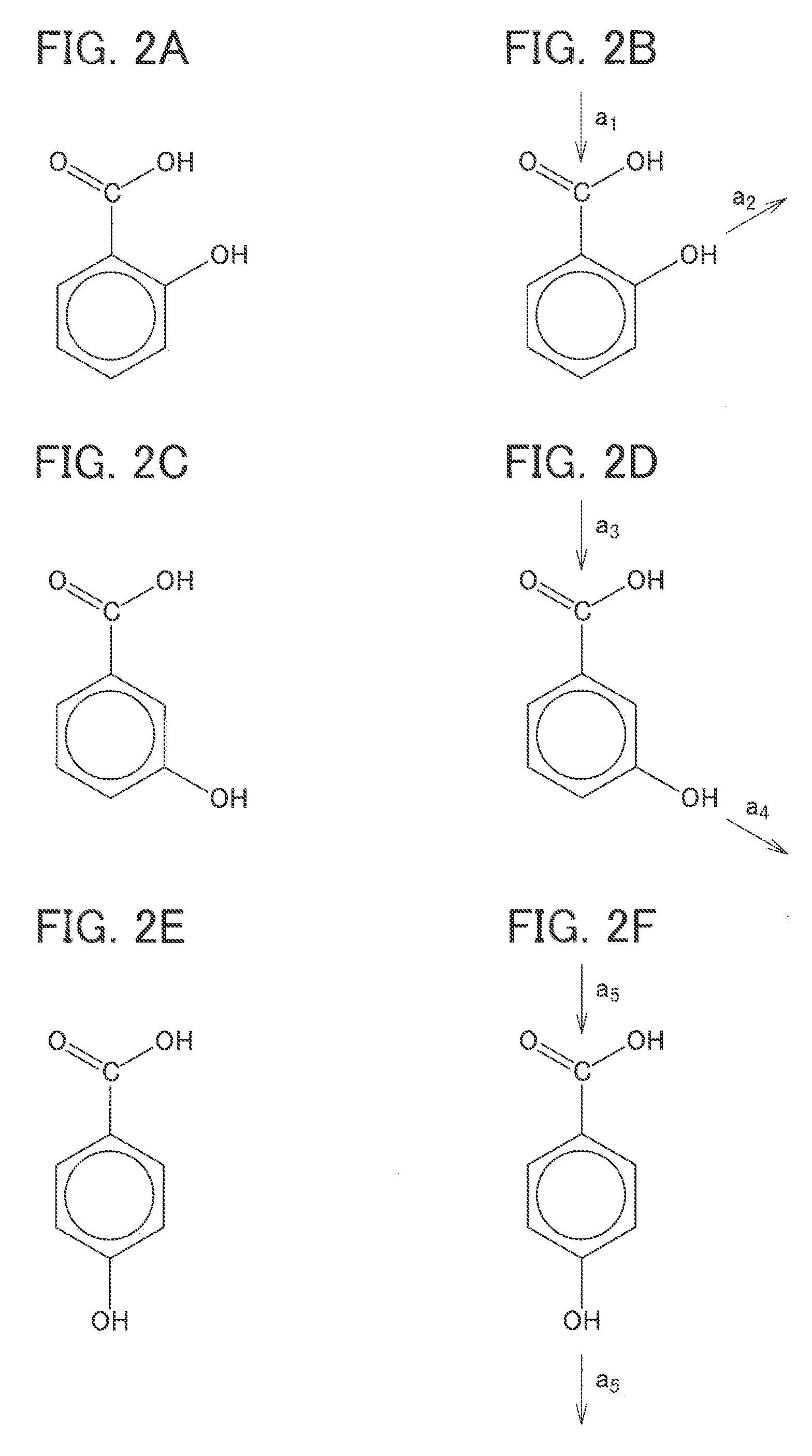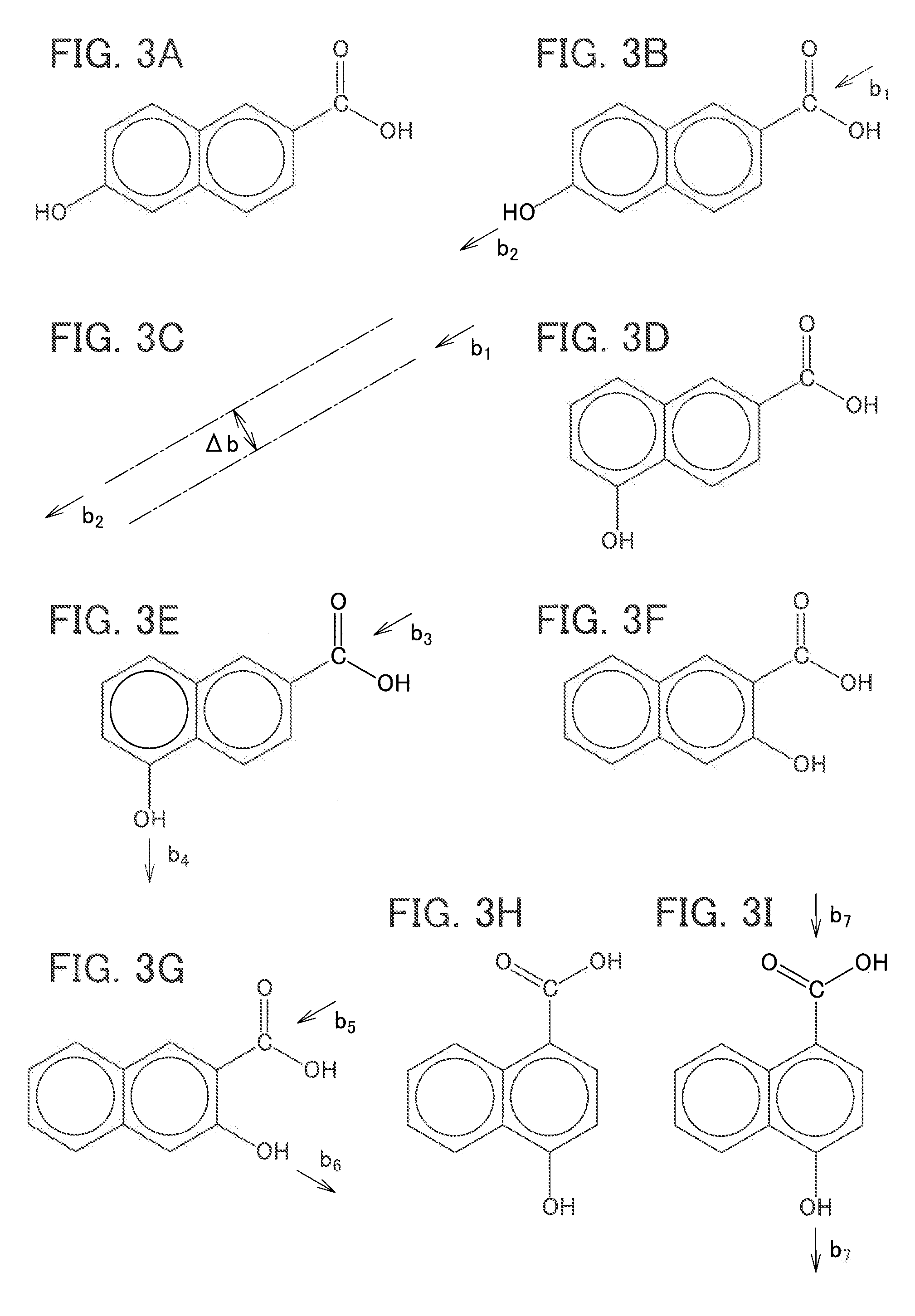Liquid-crystal polymer and molded articles
a technology of liquid crystal polymer and molded parts, which is applied in the direction of liquid crystal compositions, chemistry apparatuses and processes, etc., can solve the problems of heat dissipation inside the parts, parts have become lighter and more compact, etc., and achieve high thermal conductivity, high thermal conductivity, and sufficient mechanical strength
- Summary
- Abstract
- Description
- Claims
- Application Information
AI Technical Summary
Benefits of technology
Problems solved by technology
Method used
Image
Examples
example 1
[0101]The raw material monomers, the metal catalyst, and the acylating agent shown below were introduced into a polymerization vessel equipped with a stirrer, a reflux column, a monomer inlet, a nitrogen inlet, and a depressurizing / discharging line, which was then flushed with nitrogen gas.[0102](I)4-hydroxybenzoic acid (4-HBA): 217.1 g (73 mol %)[0103](II)6-hydroxy-2-naphthoic acid (HNA): 20.3 g (5 mol %)[0104](III)4-dihydroxybiphenyl-4-carboxylic acid (HBCA): 101.5 g (22 mol %) catalyst of potassium acetate: 22.5 mg
acetic anhydride: 224.2 g
[0105]After introducing the raw material, the temperature of the reactant was raised to 140° C., followed by allowing to react at 140° C. for 1 hour. Thereafter, the temperature was raised to 320° C. over 5 hours, then the pressure was reduced to 10 Torr (i.e. 1330 Pa) over 20 minutes, followed by subjecting to melt polymerization while distilling acetic acid, excessive acetic anhydride, and other low-boiling substances. When a stirring torque r...
example 2
Comparative Examples 1 to 5
[0106]Polymers were obtained similarly as Example 1 except that species and amounts of monomers introduced of raw material were set to those shown in Tables 1, 2, and final polymerization temperature was set to a temperature of Tm of the resulting polymer plus from 20° C. to 40° C. The results are shown in Tables 1, 2. Abbreviated names of raw material monomers used are indicated below.[0107](IV) isophthalic acid (TA)[0108](V) 4,4′-dihydroxybiphenyl (BP)
examples 3 , 4
Examples 3, 4
Comparative Examples 6, 7
[0109]The raw material monomers, the metal catalyst, and the acylating agent shown below were introduced into a polymerization vessel equipped with a stirrer, a reflux column, a monomer inlet, a nitrogen inlet, and a depressurizing / discharging line, which was then flushed with nitrogen gas.[0110](I)4-hydroxybenzoic acid (4-HBA): 215.1 g (73 mol %)[0111](II)4-dihydroxybiphenyl-4-carboxylic acid (HBCA): 123.4 g (27 mol %)
catalyst of potassium acetate: 22.5 mg
acetic anhydride: 222.1 g
[0112]In Examples 3 and 4, after the raw material was introduced, the temperature of the reactant was raised to 140° C., followed by allowing to react at 140° C. for 1 hour. Thereafter, the temperature was raised to 380° C. over 5 hours, then the pressure was reduced to 10 Torr (i.e. 1330 Pa) over 20 minutes, followed by subjecting to melt polymerization while distilling acetic acid, excessive acetic anhydride, and other low-boiling substances. When a stirring torque r...
PUM
| Property | Measurement | Unit |
|---|---|---|
| Specific volume | aaaaa | aaaaa |
| Specific volume | aaaaa | aaaaa |
| Nuclear radiation | aaaaa | aaaaa |
Abstract
Description
Claims
Application Information
 Login to View More
Login to View More - R&D
- Intellectual Property
- Life Sciences
- Materials
- Tech Scout
- Unparalleled Data Quality
- Higher Quality Content
- 60% Fewer Hallucinations
Browse by: Latest US Patents, China's latest patents, Technical Efficacy Thesaurus, Application Domain, Technology Topic, Popular Technical Reports.
© 2025 PatSnap. All rights reserved.Legal|Privacy policy|Modern Slavery Act Transparency Statement|Sitemap|About US| Contact US: help@patsnap.com



